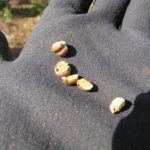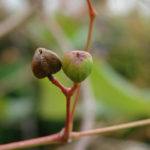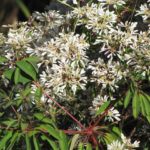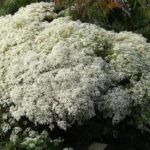Plant of the Month: Snow bush




This time of year, sales of poinsettia plants are second only to Christmas trees. Both are definitely part of the seasonal décor for those who celebrate this winter holiday. Though the fir relatives that are traditionally used for Christmas trees don’t grow at lower elevations here, we do often find tropical trees like Cook Island pines substituting for the old standard.
The poinsettia is a tropical plant, however, and can be grown outdoors year-round here in Hawaii. You will often see them planted with their close relative, euphorbia leucocephala, which provides a wonderful white flowering contrast to the deep red and green of the poinsettia (euphorbia pulcherrima). Consider adding some drama to your décor by combining the E. leucocephala with your poinsettias outdoors or in a large pot indoors.
The euphorbia with the small white inflorescence has many common names. The name snow bush, which is used locally, is an accurate description of the plant in bloom. The white blossoms that cover it make it look like a snowball. Other names include Snows of Kilimanjaro and snow flake bush, each one accurately describing the bright white color of the plant in bloom.
Snow bush is endemic to tropical areas of Mexico and Central America, but now grows throughout the tropics. It is cultivated in many Hawaiian gardens as a hedge or specimen plant and can also be found growing wild in some dry forested areas in West Hawaii.
Similar to others in the euphorbiaceae family, the inflorescence of the snow bush consists of the showy leaf bracts with a tiny flower in the center. Like the poinsettia, snow bush’s blooming cycle is triggered by cooler weather as well as long nights and short days. If night temperatures rise above 70 degrees, or if plants are grown in an area that gets nighttime lighting, buds may not form.
The 1-inch flowers usually develop in late October and bloom well into the New Year. Unlike other europhorbias, the white flowers of this plant are very fragrant. When in bloom, their sweet smell lingers in the air. After flowering, pollinated blossoms will set fruit containing seeds that can be used for propagation.
During the rest of the year, the snow bush is a rather nondescript shrub with small oval green leaves. Mature plants range from 4-8 feet tall and can get 6 feet wide. To keep them from becoming rangy and to maintain a compact shape, they should be subjected to a hard pruning annually.
Since bud development begins early in the following fall, it is best to prune soon after winter flowering is complete or shortly after the fruit containing seeds has dried. This allows lots of time for branch and bud development. Care should be taken when pruning to avoid contact with the milky sap that causes skin irritation in some people.
The small, fleshy, green pods that develop following the snow bush’s bloom can be removed once they have dried on the plant. Inside the dry pod, you’ll find three or more seeds. Be sure to remove them and save them to plant or share with others, or donate to the Community Seed Library. Planted in a good seeding mix that drains well, the seeds should geminate in a few weeks and can be grown in a pot until they start to put out true leaves.
Propagation by cuttings is also possible. After the bloom cycle, cut a woody stem of about 4 inches, dip it in a rooting hormone and set it in a mix of half perlite and half vermiculite. Cut off most of the leaves and keep the medium moist — but not wet — until new leaves form.
Once the plant has a healthy start in the propagating medium, you can transfer it to a pot or an outdoor location and fertilize lightly. The plant will thrive in a full sun location in a wide range of soil types as long as they drain well and fall within a pH range between 6.1 and 7.8 (pH below neutral 7 is slightly acid, above is slightly alkaline). Snow bush will not do well in deep shade or soggy, wet soil. It is a shrub and is best grown outside unless you have a large pot and adequate space for it indoors.
Consider installing a snow bush with or near your poinsettia this year. The two bloom simultaneously and offer a lovely display when grown together. Today, you can find poinsettias in light shades of white or pink but the deep red or variegated blossoms are particularly stunning when set off by the white blooms of the snow bush.
Both euphorbias are drought tolerant and can tolerate infrequent watering but need well-drained soil in rainy areas. Both are somewhat wind sensitive. The delicate, woody and somewhat brittle branches of the snow bush are particularly vulnerable to strong winds.
Snow bush is minimally impacted by insects or diseases but can be more vulnerable when grown in mass plantings or where branches are thickly clustered from lack of pruning. In crowded or very dry conditions, mites and whiteflies may arrive and should be treated appropriately as soon as they appear. A complete fertilizer applied every few months after flowering will ensure healthy new growth to support abundant flowering in the next bloom cycle.
This time of year, lots of poinsettias are available. Though snow bush may be harder to find, local garden departments and nurseries can usually get them for you if they don’t have them in stock.
Enhancing your winter décor with snow bush will add something new and likely garner lots of admiring complements from friends and family.
Diana Duff is a plant adviser, educator and consultant living on an organic farm in Captain Cook.
Gardening Events
Thursday: Hawaii State Trade Expansion Program from 8:45-11 a.m. at the Hawaii SBDC Office at NELHA, 73-90 Makako Bay Drive. Information on what HiSTEP 2018 can offer for export market development, assistance funding and trade show support will be covered. Register online for this free workshop at https://www.eventbrite.com/e/histep-2018-kick-off-seminar-kona-tickets-39336291908. For more information call the Hawaii Small Business Development Center at 333-5000.
Friday: Application deadline for 2018 Master Gardener Volunteer Training Program; course begins Jan. 23 and runs Tuesday mornings through mid-April. The three-hour classes are held at the Kona Extension Office in Kainaliu from 9 a.m. to noon. Course fee is $175. Info/apply: Visit www.ctahr.hawaii.edu/UHMG/WestHI/index.asp or contact Ty McDonald at 322-4884 or tym@hawaii.edu.
Saturday: “Work Day at Amy Greenwell Garden,” 9 a.m.-12:30 p.m. Meet at the Garden Visitor Center across from the Manago Hotel in Captain Cook. Volunteers will be able to help with garden maintenance and are invited to bring a brown bag lunch. Water and snacks provided. Info: Call Peter at 323-3318.
^
Farmer Direct Markets
Wednesday: “Sunset Farmers Market,” 2-6 p.m. in the HPM parking lot, 74-5511 Luhia St., in Kailua-Kona
Wednesday: “Hooulu Farmers Market,” 9 a.m.-2 p.m. at Sheraton Kona Resort & Spa at Keauhou Bay
Friday: “Pure Kona Market,” 9 a.m.-5 p.m. at Amy Greenwell Garden in Captain Cook
Saturday: “Keauhou Farmers Market,” 8 a.m.-noon at Keauhou Shopping Center
“Kamuela Farmer’s Market,” 7 a.m.-noon at Pukalani Stables
Sunday: “Pure Kona Green Market,” 9 a.m.-2 p.m. at Amy Greenwell Garden in Captain Cook
Tuesday-Saturday: “U-Pick greens and produce,” 10 a.m.-4 p.m. at Tropical Edibles Nursery in Captain Cook
^
Plant Advice Lines
Anytime: konamg@ctahr.hawaii.edu
Tuesdays, Thursdays: 9 a.m.-noon at UH-CES in Kainaliu at 322-4892
Mondays, Tuesdays, Fridays: 9 a.m.-noon at UH-CES in Hilo at 981-5199 or himga@hawaii.edu





